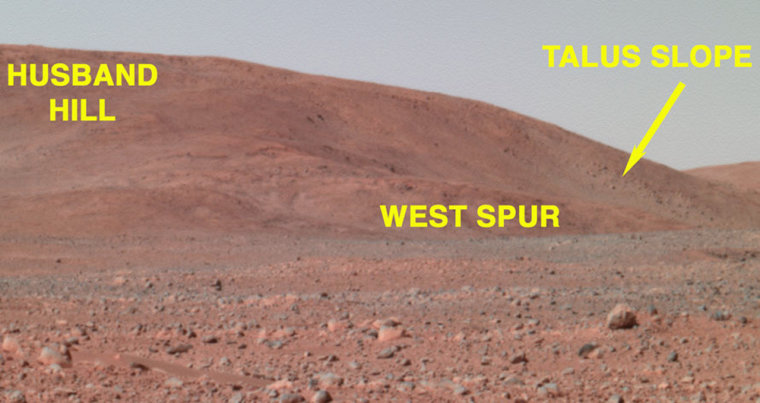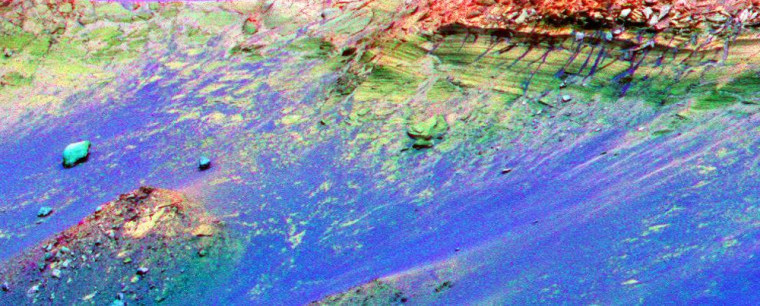To the delight of its mission scientists, NASA's Mars rover Spirit has spotted a potential rock outcrop and slopes covered in boulders on a set of hills the robot has been steering toward for more than a month.
"It's tantalizing now that we are seeing large rocks," James Rice, rover science team manager, said of the hills. "This is a really pulverized, beaten-up area of terrain."
Researchers hope that Spirit's access to the larger rocks and boulders will help them determine how hills form on Mars, whether it be by volcanism, tectonic plate uplift or some other process. A closer look at the region, dubbed the Columbia Hills, may also additional clues as to whether Gusev Crater — Spirit's landing site — was once a wetland.
Meanwhile, Spirit's robotic twin, Opportunity, is backtracking its way around the rim of Endurance Crater to study an area that may serve as the gateway down to the crater's floor. Well into their extended missions to explore the Red Planet, the two rovers continue to perform their duties despite a pair of software glitches, spaced eight days apart, that delayed Spirit's progress toward the Columbia Hills.
Spiriting to the hills
An unlikely software glitch on May 16 prompted a computer reboot aboard Spirit and forced rover handlers to spend the next two Martian days — called sols — confirming the robot's position. An unrelated software anomaly occurred on May 31 and halted Spirit's progress for another three sols while mission controllers patched the problematic software and reacquired rover position.
"I don't think these specific errors are due to age or the duration of this mission," Joe Snyder, a Lockheed Martin software engineer and member of the Mars Exploration Rover mission team, said during a briefing at NASA's Jet Propulsion Laboratory in Pasadena, Calif. "These two specific [errors] could have occurred during the start of the mission or any time in between."

Once thought to be too distant for Spirit to reach, the Columbia Hills are now about 1,312 feet (400 meters) away. To date, Spirit has driven 1.8 miles (2.9 kilometers), and JPL researchers expect to reach the hills within the next 10 days.
Spirit's first encounter with the hills will be at a point called "West Spur," where the rover has seen a series of rocky terraces suggesting the possibility of layered material there. The rover has also picked up slopes where boulders have rolled down from higher regions, and a possible outcrop, though researchers won't know for sure until Spirit moves closer towards the spur.
"This is basically a brand new mission starting right now," Rice said.
Opportunity endures at craterOn the Martian plains of Meridiani Planum, the Opportunity rover is retracing a path that took it halfway around the 430-foot-wide (130-meter-wide) Endurance Crater.
Their target is a region called "Karatepe," which could be a potential entry and exit point into the crater should rover team members decide it is necessary.
"If we go in, there is the possibility we may not come out again," said Matt Wallace, operations manager for Opportunity at JPL.
Wallace said rover team members have been using a JPL-based rover identical to Opportunity to see how the robot could perform on different terrain and slopes, but the final trip is still an unknown.
In the meantime, Opportunity has found that the floor of Endurance is covered in basalt, a rock type that makes up most of the ocean floor on Earth. Some of the Martian basalt appears to stem from rocks along the crater rim.
"There are a few places that we see may actually have been a source for this basalt," explained Wendy Calvin, a rover science team member from the University of Nevada in Reno. "So we want to chase down this basalt story."
Using its robot arm-mounted microscopic imager, Opportunity has also spotted ripple structures and cavities left by crystals that once sat in Martian rocks, she added.
Opportunity has routinely been spending its nights in a "deep sleep" mode, saving energy that was being lost by a heater that has been stuck on since the beginning of the mission. While the energy-saving effort has been successful, the dropping temperature of Martian nights is reaching the point that Opportunity's Miniature Thermal Emission Spectrometer, or Mini-TES, could eventually fail. The electronics box for the instrument needs to be warmed at night to function perfectly.
"The Mini-TES instrument has been surviving and performing well through the night, but it is a possibility the instrument will be damaged," Wallace said.
